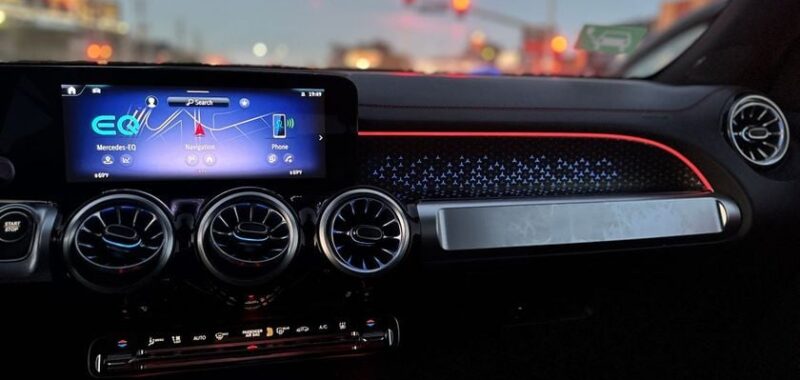
The EQB’s interior is endlessly configurable with 10 “color worlds” of ambient light and numerous “Sound Experiences.”
You could call the all-electric Mercedes-Benz EQB 250+ “practical luxury.” This compact crossover SUV is not only an electric extension of the gas-powered GLB SUV but also the lowest-priced Mercedes electric model. And it comes with the luxury brand’s refinements and personalization.
You can also get a third row if you need it.
The EQB 250+ starts at $53,050 MSRP, the entry point for the Mercedes electric line. The EQB 300 and EQB 350 trim levels offer more horsepower and all-wheel drive. Buyers could step up to the midsize EQE SUV or full-size EQS SUV. The EQE and EQS sedans round out the Mercedes e-family.
Familiar Dimensions, Personalized Experience
Fleet drivers familiar with Mercedes — particularly the GLB — will find essentially the same interior layout and dimensions, dashboard design, and MBUX infotainment system as the EQB.
For a small SUV, the EQB excels in overall passenger and cargo volume, and its low load floor and square-shaped cargo area make it easier to fit larger items. Corporate fleet drivers lugging supplies will appreciate the Keyless-Go system, made standard in the 2024 model, which allows the driver to open the trunk by moving a foot under the rear bumper.
The third-row option on the EQB adds $1,250. A compact SUV is the smallest vehicle type that would fit a third row (good for people up to 5’ 4” tall, according to Mercedes). But for companies allowing personal use, the EQB converts from weekday road warrior to weekend activity hauler with the kids by a simple pull-down from the second row.
My test-drive model came with the AMG Night Package, which includes AMG body styling and appearance upgrades for an extra $3,250. Fleet buyers can forego this, as the base model has plenty of built-in illuminations and ambient lighting.
Younger fleet drivers take note: The EQB’s interior experience is endlessly configurable on the 10.5-inch display, with three styles (classic/sporty/discreet), three modes (navigation/assistance/service), and 10 “color worlds” of ambient light.
Drivers can even choose from numerous “Sound Experiences” that greet them when they enter and exit the car.
The MBUX system takes time to figure out, though is perhaps easier than other infotainment systems on today’s high-end vehicles. Everything is controlled through the touch screen or “Hey Mercedes” voice activation. These systems will only get more intelligent with AI enhancements.
Fleet drivers might like the MBUX integration with Microsoft Outlook.

The 2024 Mercedes-Benz electric compact SUV starts at $53,050 and comes with federal and fleet incentives.
EQB 250+ Offers Practical Performance
The front-wheel-drive EQB 250+ runs on a single electric motor that delivers 188 horsepower and 284 lb.-ft of torque.
The 70.5-kWh battery delivers a top range of 251 miles, a slight increase over the EQB’s first two model years. However, that’s less than EQB’s competitors Volvo XC40 Recharge (293 miles), Audi Q4 e-tron (265), and Tesla Model Y (320).
With AC charging at 9.6 kW, the EQB can be charged from 10% to 100% in 8.25 hours, plenty of time to plug in at night and start the day full. The EQB can DC fast-charged from 10% to 80% in as little as 32 minutes.
A zero-to-60 of 8 seconds won’t win any track medals. But the EQB 250+ isn’t meant for that. Consumers could spend the extra money for the faster EQB 300 or EQB 350, but they’d sacrifice range. Fleets should stick to the 250+. I found it had plenty of electric quickness off the line.

The third row is only made for humans smaller than 5′ 4″, yet is easily accessible.
Attention Assist: New Tech Detects Drowsiness
The EQB 250+ comes with the expected standard safety features that will assist drivers with braking, blind spots, lane keeping, and crosswinds. Parktronic active park assist steers you into a parking space, though I admittedly didn’t try it out.
Drivers can upgrade to Distronic cruise control, which uses radars to adapt to the traffic in front and can brake to a full halt if necessary.
Attention Assist is a surprisingly cool safety feature, and it’s standard too.
Attention Assist uses a sensor and algorithm to detect fatigued driving. The system identifies certain steering corrections and the driver’s interaction with vehicle controls to indicate drowsiness and fatigue. After also judging external factors such as road conditions and crosswinds, the system can alert the driver if necessary.

With the second and third row seats folded down, the EQB offers 62 cu. ft. of cargo space.
EQB 250+ TCO & Budget Considerations
With the shrinking initial price gulf between gas-powered and electric vehicles, EVs are starting to pencil out favorably for fleets.
Under the Inflation Reduction Act’s Section 45W, fleets can claim a $7,500 rebate on the EQB along with a $3,500 fleet rebate that beats the GLB’s by $1,500. That makes the EQB’s capitalized cost lower than that of the GLB, its closest gas-powered counterpart.
In fact, the EQB 250+ isn’t that much pricier out the door than higher-contented, non-luxury compact SUVs.
Over a three-year lease at 15,000 miles a year, fleets will also save an estimated $4,500 in fuel costs compared to the GLB.
The electric compact luxury SUV market is crowded — the TCO experts at Vincentric have data on 49 models and trim levels in this category. In overall TCO, the EQB 250+ places in the top third of this list.
EVs’ range limitations won’t work for some fleet road warriors. But as range increases incrementally with each model year, so does the percentage of drivers for whom EVs will work, and they’re leaving oil changes and gas stations behind for home charging and fewer maintenance intervals.
The Mercedes-Benz EQB 250+ fits into this equation now. It’s a good choice on the selector as a midrange reward vehicle that makes sense for fleet budgets.

